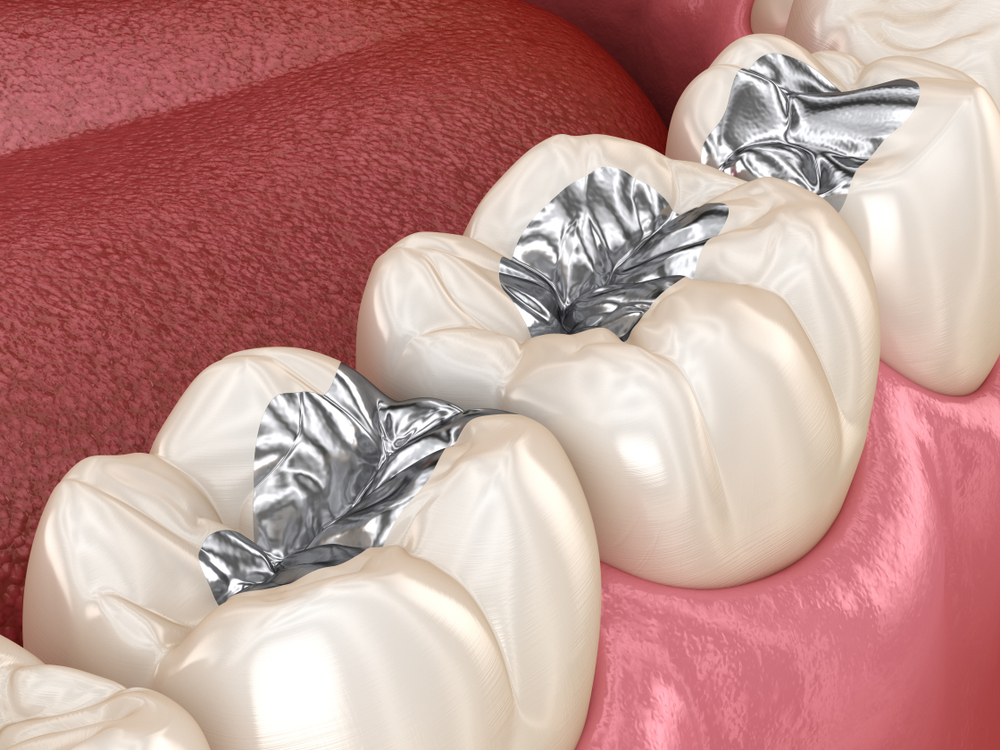
Dentleon İzmir Bornova, Çiğli, Güzelbahçe, Bayraklı Özel Diş Kliniği
What is Amalgam Filling? Can Amalgam Fillings Be Removed?
5 September 2025

Table of Contents
What is Amalgam Filling? Can Amalgam Fillings Be Removed?. 1
How is Amalgam Filling Done?. 1
What are the Advantages and Disadvantages of Amalgam Filling?. 2
Situations Where Amalgam Fillings Need to Be Removed. 2
What are the Symptoms of Amalgam Filling Poisoning?. 2
How is Amalgam Fillings Removed Performed?. 2
What Can Replace Removed Amalgam Fillings?. 2
Frequently Asked Questions About Amalgam Fillings. 3
Is Amalgam Filling Healthy?. 3
How long does an amalgam filling last?. 3
Should the amalgam filling be removed or treated?. 3
What is Amalgam Filling? Can Amalgam Fillings Be Removed?
What is Amalgam Filling?
Amalgam filling is an alloy formed as a result of the combination of metals such as silver, copper, tin and zinc with mercury. This alloy is one of the most durable filling materials that has been used in dentistry for many years. It is especially preferred in molars, which are located in the posterior regions and are most exposed to chewing force. Amalgam fillings have stood out for their durability over the years and have been safely applied to millions of patients.
Teeth weakened by caries experience both aesthetic and functional losses. Amalgam fillings close these gaps, allowing the tooth to perform its chewing function again. It is also more resistant to humid environments than some other types of fillers and has a long lifespan.
Although white composite fillings are mostly preferred for anterior teeth due to aesthetic concerns, amalgam fillings still continue to be an important option in terms of durability.
How is Amalgam Filling Done?
The application of amalgam fillings takes place in several stages and needs to be carried out carefully:
- Cleaning decayed tissue: The dentist first cleans decayed and weak structures. During this procedure, healthy parts of the tooth are tried to be preserved.
- Tooth preparation: A special cavity shape is created inside the tooth so that the filling can adhere. This stage is very important for the fillers to be used for a long time without falling off.
- Preparation of amalgam material: Metal alloys and mercury are combined in a special mixer device (amalgamator) to obtain a paste-like filling material.
- Placement of the filling: The prepared amalgam is placed in small pieces on the tooth and compressed with special tools. During this process, the voids inside the material are completely filled.
- Shaping and adaptation: As the filling begins to harden, your dentist shapes it to match the natural structure of the tooth. A precise adjustment is made so that no high or low areas are formed during chewing.
- Final check: After the filling is placed, the patient closes his jaw and performs bite tests. In this way, it is ensured that the filling is compatible with chewing movements.
Amalgam fillings harden shortly after application, but it may take several hours to reach full durability. For this reason, your doctor may recommend that you do not eat for the first 1-2 hours after the procedure.
Thanks to its durability, amalgam fillings can be used for many years, even 10-15 years, without any problems. This period can be extended further with regular dentist check-ups.
What are the Advantages and Disadvantages of Amalgam Filling?
Advantages:
- It is durable and long-lasting.
- It is resistant to chewing forces.
- It is a cost-effective option.
Disadvantages:
- Aesthetically, it has a gray-black appearance.
- It causes health discussions because it contains mercury.
- Over time, it can cause discoloration and cracks in the tooth.
Situations Where Amalgam Fillings Need to Be Removed
Amalgam fillings are not always fillings that need to be removed. However, in some cases, replacement may be necessary:
- Breakage or wear of the filling
- Re-decay in the tooth
- Aesthetic concerns
- Allergic reactions
What are the Symptoms of Amalgam Filling Poisoning?
People with mercury sensitivity may experience the following symptoms:
- Headache
- Metallic taste in the mouth
- Fatigue and weakness
- Concentration problems
How is Amalgam Fillings Removed Performed?
Removing amalgam fillings requires a special procedure. The dentist uses special aspirator systems and protective methods to avoid exposure to mercury vapor while the filling is removed. The filling is carefully cleaned, and the tooth is prepared for the new filling.
What Can Replace Removed Amalgam Fillings?
After amalgam fillings are removed, the following alternatives can be applied:
- Composite fillings
- Ceramic fillings
- Inlay and onlay restorations
These options are more aesthetically advantageous and provide a natural tooth appearance. In addition, in some cases, implant treatment may be preferred for missing teeth.
Frequently Asked Questions About Amalgam Fillings
Is Amalgam Filling Healthy?
Amalgam fillings are a filling material that has been used in dentistry for over 150 years and is known for its durability. It contains metals such as silver, tin, copper and mercury. It has been safely preferred for many years because it is highly resistant to chewing force, especially in the back teeth. However, the mercury substance in amalgam fillings has occasionally caused controversy in terms of health. The World Health Organization (WHO) and many health organizations state that amalgam fillings are generally safe when applied correctly. However, some people may experience allergic reactions or metal sensitivity. Today, with increasing aesthetic expectations and the development of more biocompatible materials, dentists often recommend composite fillings or ceramic-based alternatives.
How long does an amalgam filling last?
Thanks to their durability, amalgam fillings can last an average of 10-15 years, and in some cases up to 20 years. This period may vary depending on the size of the filling, the location of the tooth, the patient’s oral hygiene and regular dental check-ups. Brushing your teeth regularly, flossing, and visiting the dentist at least twice a year extend the life of fillings. Additionally, habits such as clenching and grinding can cause fillings to wear out more quickly.
Should the amalgam filling be removed or treated?
Amalgam fillings do not need to be removed as long as they are intact and there are no caries, cracks or leakage problems in the tooth. Because healthy tooth tissue can also be lost during unnecessary removal. However, your doctor may recommend replacing the filling in the following cases:
- If there are fractures, cracks or abrasions in the filling,
- If there is caries on the edges of the filling,
- If it is aesthetically disturbing,
- If there are health problems due to metal or mercury sensitivity.
During the removal of the filling, special vacuum systems and protective measures are used. In this way, exposure to mercury vapor is minimized and the tooth is treated with a new, more aesthetic filling.
Result
Amalgam fillings are very durable and economical filling materials that have been used safely for many years. However, today, due to both aesthetic concerns and discussions about mercury, composite resin fillings or porcelain-based fillings are mostly preferred. If you doubt or want to replace your current amalgam fillings, you should definitely consult a dentist to make the best decision. Your dentist will offer you the most appropriate and healthiest treatment option according to the condition of your tooth.
Recent Posts



